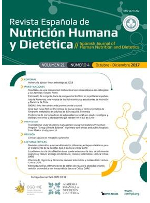Disponibilidad e interpretación del etiquetado de productos lácteos en Montevideo – Uruguay: estudio transversal sobre Declaraciones de Propiedades Nutricionales referidas a energía y grasas totales
DOI:
https://doi.org/10.14306/renhyd.23.4.741Palabras clave:
Etiquetado de Alimentos, Comportamiento del Consumidor, Productos Lácteos, Grasas de la Dieta.Resumen
Introducción: Se pretende conocer la disponibilidad de productos lácteos envasados con declaraciones de propiedades nutricionales en relación a grasas y valor calórico presentes en el etiquetado que se comercializan en Montevideo, y la interpretación que hace el consumidor de los términos utilizados.
Material y métodos: Se realizó un estudio descriptivo y transversal, en productos lácteos con alegaciones nutricionales en relación a grasas y valor calórico presente en el etiquetado en comercios de la ciudad de Montevideo. La información fue obtenida del etiquetado de los alimentos. Se efectuó una encuesta a conveniencia, con preguntas cerradas a consumidores de más de 20 años, para conocer la interpretación de las alegaciones.
Resultados: El 14% de los productos lácteos disponibles en los comercios presentan alegaciones nutricionales en grasas y valor calórico, predominando éstas en los yogures y luego quesos untables. El nutriente más mencionado son las grasas. La alegación “0% grasas” se menciona en el 54% de los lácteos. El 64% de los encuestados declara que sí lee las alegaciones en el etiquetado. El principal motivo de compra mencionado es que el consumo de lácteos con reducción en energía o grasas es positivo para la salud. Se prefieren lácteos “0% grasas” y “light”.
Conclusiones: La información contenida en el etiquetado nutricional de los lácteos resulta de interés para los consumidores. Esto es positivo ya que las alegaciones pueden ser una herramienta para elegir alimentos con un menor porcentaje calórico y un menor contenido graso, lo que repercute positivamente sobre la salud de los consumidores.Citas
(1) Decreto Nº 402/012 (Publicación 20/12/2012) – Información Nutricional Complementaria (Declaraciones de Propiedades Nutricionales). Resolución Nº 1/12 del Grupo Mercado Común del MERCOSUR.
(2) Montero Marín A, Limia Sánchez A, Franco Vargas E, Belmonte Cortés S. Estudio de declaraciones nutricionales y saludables en el etiquetado de leches fermentadas. Revista Nutrición Hospitalaria. 2006; 21(3): 338-345.
(3) Bueno Borrego RM, García Peinado E, Lopez Cobos E, Mallol Goytre P, Romero Cruz J, Martínez Hernández A. Educación nutricional: Aprender a interpretar las declaraciones nutricionales y propiedades saludables del etiquetado de los alimentos y de su publicidad. Educación, Salud y TIC en contextos multiculturales: nuevos espacios de intervención. Editorial Universidad de Almería, 2017. Págs. 787-795. ISBN 978-84-16642-45-8
(4) Ministerio de Salud. 2ª Encuesta Nacional de Factores de Riesgo de Enfermedades No Transmisibles. Programa de Prevención de Enfermedades no Transmisibles PPENT. Uruguay; 2013.
(5) Ministerio de Ganadería, Agricultura y Pesca. Análisis sectorial y cadenas productivas. Tema de políticas. Estudio. Anuario 2016. Oficina de Programación y Política Agropecuaria (OPYPA). Uruguay. ISNN 1510-3943
(6) Navas-Carretero S, Martinez JA. Cause-effect relationships in nutritional intervention studies for health claims substantiation: guidance for trial design. Int J Food Sci Nutr, 2015; 66(S1): S53–S61 2015 Taylor & Francis. DOI: 10.3109/09637486.2015.1025720 http://informahealthcare.com/ijf - ISSN: 0963-7486 (print), 1465-3478 (electronic)
(7) Soederberg Miller LM, Cassady DL. The effects of nutrition knowledge on food label use. A review of the literature. Appetite. 2015; Sep 1;92:207-216. doi:10.1016/j.appet.2015.05.029. Epub 2015 May 27.
(8) Transforma Uruguay. Uruguay XXI. Promoción de Inversiones, Exportaciones e Imagen País. Oportunidades de Inversión. Sector retail. 2018. Disponible en: www.uruguayxxi.gub.uy
(9) Lopéz-Galán B, de-Magistris T. Prevalencia de las declaraciones nutricionales en la prevención de la obesidad en el mercado español. Nutr Hosp.2017;34(1):154-164 ISSN 0212-1611
(10) Azman N, Siti Zaleha Sahak. Arshad Ayub Graduate Business School, Universiti Teknologi MARA, 40450 Shah Alam, Selangor, Malaysia. Nutritional Label and Consumer Buying Decision: A Preliminary Review. ScienceDirect. Procedia- Social and Behavioral Sciences 130 (2014) 490 – 498.
(11) Muhammad Zeeshan Zafar *, Noor Azmi Hashim, Fairol Halim. Malaysia. Consumer’s perception toward health claims for healthy food selection. Journal of Scientific Research and Development 3 (1): 57-67, 2016 Available online at www.jsrad.org ISSN 1115-7569 © 2016 JSRAD * School of Business Management, College of Business, University Utara Malaysia.
(12) Mandle J, Tugendhaft A, Michalow J, Hofman K. Nutrition labelling: a review of research on consumer and industry response in the global South. Glob Health Action. 2015 Jan 22;8:25912. doi: 10.3402/gha.v8.25912. eCollection 2015
(13) López-Cano LA, Restrepo-Mesa SL, Secretaría de Salud de Medellín, Colombia. Etiquetado nutricional, una mirada desde los consumidores de alimentos. Perspect Nutr Humana. 2014;16: 145-158. DOI: 10.17533/udea.penh.v16n2a03
(14) Mitic´S, Gligorijevic´ M. Consumers' attitudes, knowledge and consumption of products with nutrition and health claims. Journal Economics of Agriculture; 2015; 62 (2): 335-352. Belgrade: Institute of Agricultural Economics. Base de datos: CAB Abstracts 1990-Present
(15) Cavaliere A, De Marchi E, and Banterle A. "Does consumer health-orientation affect the use of nutrition facts panel and claims? An empirical analysis in Italy." Food Quality and Preference 54 (2016): 110-116.
(16) Sebastian-Ponce MI, Sanz-Valero J, Wanden-Berghe C. Información percibida por los consumidores a través del etiquetado sobre las grasas presentes en los alimentos: revisión sistemática. Nutr. Hosp. 2015; 31(1): 129-142. ISSN 0212-1611
(17) Kaur A, Scarborough P, Rayner M. A systematic review, and meta-analyses, of the impact of health-related claims on dietary choices. Int J Behav Nutr Phys Act. 2017 Jul 11;14(1):93. doi: 10.1186/s12966-017-0548-1.
(18) Lopéz-Galán B, de Magistris T. ¿Habilidades emocionales o cognitivas? El rol de la inteligencia emocional en las decisiones de compra de alimentos con declaraciones nutricionales. ITEA (2017), Vol. 113 (4):376-394. ISSN 1699-6887
(19) Abrams KM, Evans C, Duff BR. Ignorance is bliss. How parents of preschool children make sense of front-of-package visuals and claims on food. Appetite. 2015 Apr;87:20-9. doi: 10.1016/j.appet.2014.12.100. Epub 2014 Dec 12
(20) Sánchez et al. Conocimientos, percepciones y comportamientos relacionados con el consumo de sal, la salud y el etiquetado nutricional en Argentina, Costa Rica y Ecuador. Rev Panam Salud Pública. 2012;32(4).
(21) Moliterno P. Importancia del consumo de lácteos en la ingesta de nutrientes y prevención de enfermedades crónicas. Puesta al día. Tendencias en Medicina. Agosto 2018; Año XIII Nº 13: 00-00. Uruguay
(22) Ministerio de Salud. Guías Alimentarias para la población uruguaya. Montevideo, Uruguay; 2016.
(23) USDA Food Composition Databases. https://ndb.nal.usda.gov
(24) Miklavec K, Pravst I, Grunert KG, Klopcic M, Pohar J. The influence of health claims and nutritional composition on consumers’ yogurt preferences. Food Quality and Preference. Vol 43, July 2015, Pages 26-33.
(25) Allemandi L, Tiscornia MV, Castronuovo L, Guarnieri L. Etiquetado frontal de productos alimenticios en Argentina. SALUD COLECTIVA. 2018;14(3):645-648. doi: 10.18294/sc.2018.2048
(26) Pollak L, Bender D, Mljekarstvo V. New challenges in the use of nutrition and health claims on milk and dairy products. Journal Article, 65 (1), Zagreb:Hrvatska mljekarska udruga - Croatian Dairy Union,2015,3-8. Base de datos: CAB Abstracts 1990-Present
(27) Manrique H, Pinto M, Sifuentes V. Etiquetado de alimentos y procesados: una herramienta necesaria para la educación alimentaria. Rev. Perú. med. exp. Salud Pública; Lima, julio /setiembre 2017; vol.34 no.3
(28) Kaur A, Scarborough P, Hieke S, Kusar A, Pravst I, Raats M and Rayner M. The nutritional quality of foods carrying health-related claims in Germany, The Netherlands, Spain, Slovenia and the United Kingdom. Eur J Clin Nutr. 2016;70(12):1388-1395.
(29) Palou Oliver A, Palou March M. La evidencia científica en la información al consumidor: las declaraciones nutricionales y de propiedades saludables (health claims) en los alimentos. Revista Española de Comunicación en Salud. 2016, ISSN: 1989-9882. Documento descargado de http://www.uc3m.es/recs
(30) Valtueña Martínez S, Siani A. Health claims made on food in the EU: The edge between scientific knowledge and regulatory requirements. Trends in Food Sciencie & Technology. November 2017, Volume 69, Part B, Pages 315-323
(31) Kaur A, Scarborough P, Rayner M. Regulating health and nutrition claims in the UK using a nutrient profile model: an explorative modelled health impact assessment. Int J Behav Nutr Phys Act, 2019 Feb 7;16(1):18. doi: 10.1186/s12966-019-0778-5.
(32) Masson E, Debucquert G, Fischler C, Merdji M. French consumers’ perceptions of nutrition and health claims: A psychosocial-anthropological approach. Appetite 2016; Volume 105, Pages 618-629.











